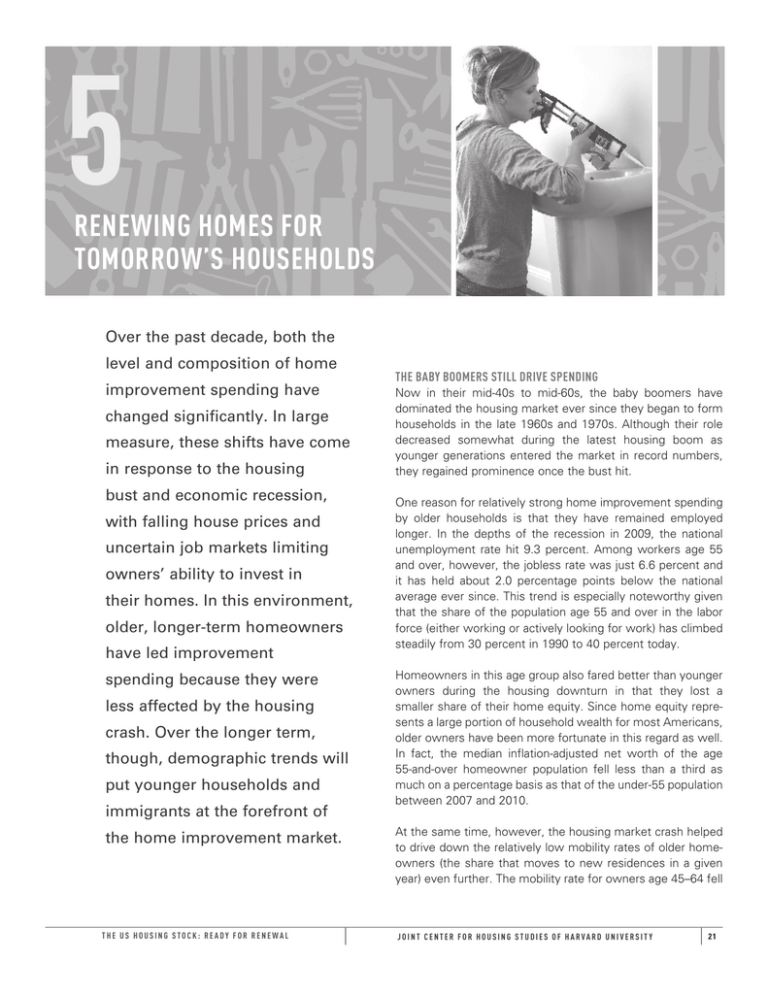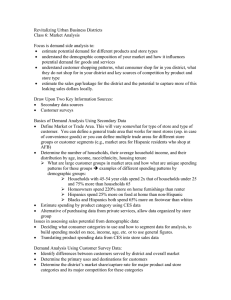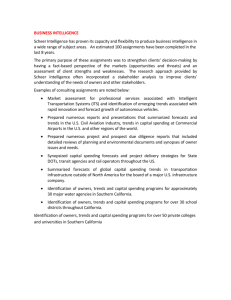5 RENEWING HOMES FOR TOMORROW’S HOUSEHOLDS Over the past decade, both the
advertisement

5 RENEWING HOMES FOR TOMORROW’S HOUSEHOLDS Over the past decade, both the level and composition of home improvement spending have changed significantly. In large measure, these shifts have come in response to the housing bust and economic recession, with falling house prices and uncertain job markets limiting owners’ ability to invest in their homes. In this environment, older, longer-term homeowners have led improvement spending because they were less affected by the housing crash. Over the longer term, though, demographic trends will put younger households and immigrants at the forefront of the home improvement market. THE US HOUSING STOCK: READY FOR RENEWAL THE BABY BOOMERS STILL DRIVE SPENDING Now in their mid-40s to mid-60s, the baby boomers have dominated the housing market ever since they began to form households in the late 1960s and 1970s. Although their role decreased somewhat during the latest housing boom as younger generations entered the market in record numbers, they regained prominence once the bust hit. One reason for relatively strong home improvement spending by older households is that they have remained employed longer. In the depths of the recession in 2009, the national unemployment rate hit 9.3 percent. Among workers age 55 and over, however, the jobless rate was just 6.6 percent and it has held about 2.0 percentage points below the national average ever since. This trend is especially noteworthy given that the share of the population age 55 and over in the labor force (either working or actively looking for work) has climbed steadily from 30 percent in 1990 to 40 percent today. Homeowners in this age group also fared better than younger owners during the housing downturn in that they lost a smaller share of their home equity. Since home equity represents a large portion of household wealth for most Americans, older owners have been more fortunate in this regard as well. In fact, the median inflation-adjusted net worth of the age 55-and-over homeowner population fell less than a third as much on a percentage basis as that of the under-55 population between 2007 and 2010. At the same time, however, the housing market crash helped to drive down the relatively low mobility rates of older homeowners (the share that moves to new residences in a given year) even further. The mobility rate for owners age 45–64 fell JOINT CENTER F OR HOUSING STUDIES OF HARVARD UNIVERSIT Y 21 from 4.1 percent in 2007 to 3.1 percent in 2011, while that for owners age 65 and over dipped from 2.7 percent to 1.8 percent. Some of these older households may have put off selling their homes until they regained a portion of the lost value or until prices stabilized. Others may have had trouble selling because potential buyers were unable to sell their own homes or obtain financing. Figure 21 Homeowners Age 55 and Over Account for Close to Half of Improvement Spending Share of Total Homeowner Improvement Spending (Percent) 35 30 But even if mobility rates return to more traditional levels as the housing market recovers, the overwhelming majority of older homeowners prefer to remain in their current homes as they age. Retrofitting their homes to accommodate their changing needs thus represents a significant opportunity for the remodeling industry. So far, many older households have yet to make these modifications. For example, although a majority of owners age 55 and older have a bedroom on the first floor to avoid stairs, only a third have wheelchair-accessible kitchens, and fewer than one in six have raised toilets, door handles rather than knobs, or wider doorways and hallways for easier navigation. Younger owners are even less likely to have such features in their homes. Undertaking home modifications to allow aging in place is expected to keep older owners active in the home improvement market. Indeed, older owners have already increased their share of expenditures on remodeling projects. A decade ago, owners age 55 and over accounted for less than one-third of all home improvement spending. By 2011, this share had grown to over 45 percent, with most of the increase occurring during the housing downturn (Figure 21). Part of this share gain, however, reflects the rising number of households in this age range once the oldest baby boomers turned age 55 in 2001. Another factor is that older households were able to sustain their high homeownership rates during the housing downturn. Even so, per-household spending among owners age 55 and up also rose over the past decade. Of the nearly $30 billion inflation-adjusted increase in home improvement expenditures in 2001–11 for this age group, higher per-owner spending accounted for almost half (48 percent). In fact, owners age 55–64 and 65 and over were the only groups that posted significantly higher inflation-adjusted per-owner spending in 2011 than a decade earlier. YOUNGER HOUSEHOLDS POISED TO LEAD While the baby-boom generation has been the driving force in the home improvement market for decades, younger households will be the primary market for remodeling projects in the coming years. In 2005, 81.2 million members of the so-called baby-bust generation (born between 1965 and 1984) were age THE US HOUSING STOCK: READY FOR RENEWAL 25 20 15 10 5 2001 2003 Age of Homeowner: ■ 2005 Under 35 ■ 2007 35–44 ■ 45–54 2009 ■ 55–64 2011 ■ 65 & Over Source: JCHS tabulations of the 2001–11 AHS. 21–40 and entering their prime home improvement spending years. Boosted by strong immigration, this group outnumbered the baby boomers when that generation was in the same age range in 1985. And when the echo boomers (born between 1985 and 2004) are age 21–40 in 2025, members of that generation will number some 91.7 million according to US Census Bureau projections. As households age, their home improvement spending grows. For example, the baby-bust generation was just beginning to enter the homebuying market in 1995 and thus accounted for only 5 percent of improvement spending by owners in that year. Their share of improvement expenditures jumped to 27 percent in 2005 and then to almost a third of the market in 2011 (Figure 22). Given that the oldest members of the echoboom generation were only in their mid-20s in 2011 and just beginning to pursue homeownership, their share of improvement spending was only about 1 percent that year. The sheer number of younger households bodes well for the remodeling industry. In the meantime, though, the housing downturn, weak economic recovery, and tight credit environment have deterred these households from buying homes. As a result, the homeownership rate among households under age 35 dropped from 43 percent in 2005 to just over 36 percent in the third quarter of 2012. The decline among households age 35–44 was equally sharp, from about 69 percent to less than 62 percent. Given historical patterns as well as recent results from Fannie Mae’s National Housing Survey, however, the JOINT CENTER F OR HOUSING STUDIES OF HARVARD UNIVERSIT Y 22 Figure 22 2 Figure 23 The Baby-Bust Generation Is Expanding Its Presence in the Home Improvement Market Share of Total Homeowner Improvement Spending (Percent) 100 5.1 54.9 0.1 1.3 26.9 32.2 80 54.3 48.9 60 40 40.0 20 18.8 17.6 2005 2011 0 1995 ■ Seniors Born before 1945 ■ Baby Boom Born 1945–64 ■ Baby Bust Born 1965–84 ■ Echo Boom Born 1985 & After Spending by Younger Owners Rose Less During the Upturn and Generally Fell More During the Downturn Average Annual Per-Owner Improvement Expenditures (2011 dollars) 2011 Percent Change 2001–07 Percent Change 2007–11 2,950 2,200 36 -25 2,960 4,020 2,700 36 -33 45–54 2,750 3,650 2,610 33 -28 55–64 2,420 3,670 2,590 52 -29 65 and Over 1,390 2,130 1,840 53 -14 Total 2,330 3,280 2,370 41 -28 Age of Homeowner 2001 2007 Under 35 2,170 35–44 Source: JCHS tabulations of 2001, 2007 and 2011 AHS. Source: JCHS tabulations of 2001, 2007 and 2011 AHS. Source: JCHS tabulations of the 1995, 2005 and 2011 AHS. overwhelming majority of young households expects to buy homes sometime in the future. Many younger households that did manage to purchase homes during the housing boom lost significant equity during the bust. Since many bought near the peak of the market, they had little opportunity to benefit from the long run-up in home values. In 2007, homeowners of all ages held an average of $199,000 in equity; by 2011, that figure had dropped 23 percent to $154,000. But owners under the age of 35 saw their equity fall some 32 percent over this period, from $85,000 to about $58,000. The equity of owners age 35–44 declined by the same percentage, from $160,000 to $109,000. According to Joint Center analysis, the share of owners under age 35 with less than 20 percent equity in their homes thus increased from 36 percent in 2007 to 44 percent in 2011, while that of owners age 35–44 rose from 19 percent to 30 percent. As noted earlier, owners with less than 20 percent equity spend significantly less on home improvements. Indeed, lower home equity not only limits the amount that owners can borrow to undertake projects, but it also discourages any investment at all. As a result, after climbing sharply between 2001 and 2007, overall inflationadjusted per-owner improvement spending fell some 28 percent by 2011, with owners age 35–44 posting the largest declines (Figure 23). Meanwhile, many other younger individuals were unable to form independent households, doubling up instead with family THE US HOUSING STOCK: READY FOR RENEWAL or other individuals to wait out the Great Recession. Between 2005 and 2011, the number of owner households that included one or more adult children (age 21 or older) increased 15 percent, from 8.9 million to 10.2 million. All of these conditions—the decline in both household formation and homeownership rates, and the loss of equity among those who did buy homes—served to depress improvement spending among younger households after the housing crash. The presence of adult children in the household (either those who continued to live with parents or moved back in after living independently) also appears to have had a dampening effect on spending. THE ROLE OF IMMIGRANTS The US Census Bureau reports that more than 40 million foreign-born people resided in the United States in 2011, accounting for 13 percent of the population. These individuals make up nearly 16 million households, or 14 percent of the national total. With 37 percent growth since 2001 (and 4 percent since 2007, despite the weak economy), foreign-born homeowners generated $16 billion in home improvement spending in 2011 (Figure 24). Home improvement spending by immigrant owners tends to be geographically concentrated. Immigrants traditionally cluster in key gateway cities when they first arrive in the United States, thus accounting for a significant share of the local population. Indeed, the immigrant share of homeownJOINT CENTER F OR HOUSING STUDIES OF HARVARD UNIVERSIT Y 23 ers exceeds one-third in Los Angeles, Miami, and San Jose. Not surprisingly, foreign-born owners in these metros also accounted for at least 30 percent of home improvement spending in 2011—the highest immigrant spending shares for any major metro areas in the country. The recent decline in the foreign-born share of overall improvement spending reflects the fact that these households disproportionately live in the urban areas of the South and West, where the housing bust hit particularly hard. In addition, foreign-born households have lower homeownership rates than native-born households. They also tend to be younger, which means that they have recently faced the same difficult housing market conditions as their nativeborn counterparts. Moreover, the composition of the immigrant population has shifted in ways that depress spending among this group. While the total foreign-born population increased by 2.3 million between 2007 and 2011, the number of immigrants from Europe and Canada fell over this period, as did those from Mexico. These declines were more than offset by inflows from Central and South America (up almost 1.0 million), and from Asia and the Middle East (up 1.4 million). In 2011, per-owner improvement spending for foreign-born households was 17 percent lower on average than for native-born households. But spending among European and Canadian immigrants was more than 20 percent higher than among the native born. The declining share of immigrants from these regions thus served to reduce average improvement spending among foreign-born homeowners. Figure 24 Immigrant Homeowners Remain an Important Remodeling Market Segment Improvement Spending by Foreign-Born Homeowners 25 20 8.6 Even after the housing market recovers, the aging of the US population will continue to have a profound impact on home improvement demand. According to Joint Center projections, about 12.5 million households age 55 or older will be added on net between 2010 and 2020, while the number of households under age 55 will change only modestly. The housing choices of these older households will therefore shape the remodeling market over the next several years. In particular, lower mobility rates among older owners will likely drive growing demand for retrofits to allow aging in place. While housing turnover is also associated with higher improvement spending, Joint Center research has shown that among older owners who have lived in their homes for at least 10 years, spending does not decline with duration of residence. Even those who have lived in their homes for 20 years THE US HOUSING STOCK: READY FOR RENEWAL 10.1 10 9.1 19.1 18.7 15 8 16.1 6 10 11.1 11.0 4 5 2 0 2001 2003 2005 2007 2009 0 2011 ■ Spending by Foreign-Born (Left scale, billions of dollars) ■ Foreign-Born Share of Total Market Spending (Right scale, percent) Source: JCHS tabulations of the 2001–11 AHS. Figure 25 Remodeling Expenditures Decline with Age of the Owner, But Not with Length of Time in the Home Average Annual Per-Owner Spending in 2011 (Dollars) 3,000 2,500 TOMORROW’S HOME IMPROVEMENT MARKET 8.2 12 10.4 23.8 10.1 2,000 2,760 2,450 2,540 2,050 2,160 2,180 1,500 1,590 1,500 1,230 1,000 500 0 55–64 65–74 75 and Over Age of Homeowner Years in Home: ■ Under 10 ■ 10–19 ■ 20 and Over Source: JCHS tabulations of the 2011 AHS. JOINT CENTER F OR HOUSING STUDIES OF HARVARD UNIVERSIT Y 24 or more spend about the same on improvements as same-age owners who have lived in their homes for less time (Figure 25). Still, the longer-term health of the remodeling industry ultimately depends on the housing decisions of younger households. Members of the baby-bust generation are just reaching their prime home remodeling years, and with the help of strong immigration, they are nearly as large a market as the baby boomers. And the echo-boom generation is already slightly larger than the baby-boom generation in terms of births. The US Census Bureau projects that when they reach the 21–40 age range in 2025, they will outnumber the baby boomers at those same ages by more than 12 million (16 percent). In addition, foreign-born households will contribute an increasing share of population growth. By 2015, net inter- THE US HOUSING STOCK: READY FOR RENEWAL national migration is predicted to account for under a third of net population growth in the country, according to the US Census Bureau. This share should increase to more than 40 percent by 2025, before climbing to nearly 50 percent by 2030—thus continuing to augment the size of the already large younger generations. In the near term, older households are thus helping to bolster the remodeling market by retrofitting their homes in ways that enable them to age in place. Demand for home improvement projects from this older group will help sustain spending until the baby-bust generation begins to dominate the market over the coming decade. The potential for even stronger growth in homeowner spending will come when the echo boomers start to reach their peak remodeling years near the middle of the next decade. JOINT CENTER F OR HOUSING STUDIES OF HARVARD UNIVERSIT Y 25



